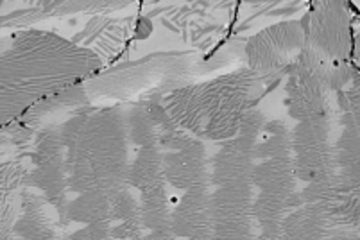All genres
601.
Talk
Materials design and discovery on the computer: Prospects and challenges. Kolloquium Universität Braunschweig , Braunschweig, Germany (2015)
602.
Talk
Deformation-driven phase transition in severely cold-deformation pearlitic steel. General Meeting on the Mechanics of Nano-Objects, Marseille, France (2015)
603.
Talk
Temperature-dependent coupling of atomic and magnetic degree of freedom from first-principles. Electronic Structure Theory for the Accelerated Design of Structural Materials, Moscow, Russia (2015)
604.
Talk
Supersaturated ferrite in severely cold-drawn pearlitic steel - X-ray diffraction study. Pearlite Workshop, MPI für Eisenforschung GmbH, Düsseldorf, Germany (2015)
605.
Talk
Towards automated toolsets for computing high-precision free energies by ab initio approaches. MS&T, Columbus, OH, USA (2015)
606.
Talk
Design of structural materials by ab initio guided multiscale simulations. CMRI Symposium, Sendai, Japan (2015)
607.
Talk
Mastering the structural and thermodynamic complexity of modern materials. ESTADSM Conference, Moskau, Russia (2015)
608.
Talk
Stand ICMPE in Wissenschaft und Industrie. VDI-GME Werkstoffdialog, Maria Laach, Germany (2015)
609.
Talk
Ab initio explanation of off-stoichiometry in Fe–Mn–Al–C κ carbides. Intermetallics 2015, Bad Staffelstein, Germany (2015)
610.
Talk
Ab initio guided design of structurally and thermodynamically complex materials. PSIK Conference, San Sebastian, Spain (2015)
611.
Talk
Ab Initio Computation of Phonon-Phonon and Magnon-Phonon Interactions: Successes and Challenges. Workshop DyProSo, Freising, Germany (2015)
612.
Talk
Design of structural materials by predictive ab initio thermodynamics: Challenges, applications and perspectives. Euromat Conference, Warsaw, Poland (2015)
613.
Talk
Formation Energy of Halide ions (Cl/Br/I) in water from ab-initio Molecular Dyna. Psi-k 2015 Conference, San Sebastián, Spain (2015)
614.
Talk
Quantum-mechanical approaches to address the structural and thermodynamic complexity of engineering materials. Swedish Chemical Society, Kalmar, Sweden (2015)
615.
Talk
Understanding the fundamental mechanisms behind H embrittlement: An ab initio guided multiscale approach. Colloquium UCB Vancouver, Vancouver, Canada (2015)
616.
Talk
Vacancies in fcc metals: Discovery of large non-Arrhenius effects. The 5th Sino-German Symposium Thermodynamics and Kinetics of Nano and Mesoscale Materials and Their Applications, Changchun, China (2015)
617.
Talk
Coupling of magnetic and lattice degrees of freedom in bulk materials. Magnetism Workshop, Fagerudd, Sweden (2015)
618.
Talk
Scale hoping simulations and real atoms. ICAMS Workshop ‘From Atoms to Continuum’,ICAMS, Ruhr University Bochum, Bochum, Germany (2015)
619.
Talk
PyIron – A Python Based Workbench for Automated Atomistic Simulations. CECAM Conference, Lausanne, Switzerland (2015)
620.
Talk
From surface modeling to novel semiconductor growth strategies. MDRC Conference on Material Defects, Lake Arrowhead, CA, USA (2015)











